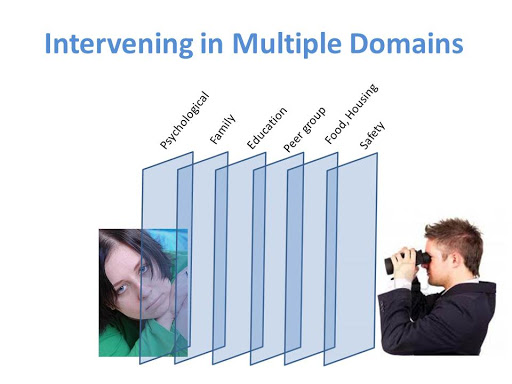29th March 2018

Why intervene in multiple domains?
Making deliberate attempts to work in multiple domains is one of the Core Features of AMBIT and there are a range of Training Exercises for Working in multiple domains in this manual. This element of the AMBIT stance is increasingly recognised in policies that encourage a broader set of core skills (see The Common Core of skills and knowledge.)
We recognise the complex and 'multifactorial' causes of many of the problems faced by young people - it is rare that problems have a single cause. Practitioners are trained to work across a range of intervention modalities (Specific interventions). Intervening in a single domain (such as the domain of individual psychology - beliefs and motivations, etc) ALONE is not AMBIT, unless there are explicit efforts to work in at least one other domain.
Multiple interventions
The kind of interventions a worker might use will often have been developed in, or may be seen traditionally as the province of separate professional groupings. Having a wider range of "barefoot" skills, equips the KeyWorker for active, flexible, "light-footed", non-clinic-based, “frontline” or “street-level” work, allowing the person of the worker him or herself to act in an integrative role (see Taking Responsibility for integration, one of the Core Features of AMBIT), rather than exposing the young person to multiple professionals at a time when developing a therapeutic attachment to just one individual may be hard enough. One of the purposes of this approach is precisely to reduce the need for a young person to be seen by different specialists and, through a willingness to work across different domains of functioning, to invest in the development of a helping relationship with the AMBIT keyworker (see Engagement and the Therapeutic relationship).
There is a strong focus on effective practice (see Respect for Evidence) – using manualized evidence-based treatment modalities as far as possible, albeit in settings that have previously not been seen as ideal for these to be delivered within.
What are "domains"?
1. Biological
Workers have an understanding not of psychopharmacology (which remains the province of the prescriber) but of:
1. Key physical signs that would indicate a need for closer medical assessment,
2. The rationale for using medication
3. Tools for developing and sustaining adherence to pharmacological treatment regimes, both addressing the individual and the systemic context (engaging family-members in the task of supporting adherence to a prescription, for instance.)
2. Individual psychological
Workers have skills in:
1. Mentalization-based approaches to therapy
2. Basic CBT
3. Motivational approaches
4. Psychoeducational techniques.
3. Family/care network
The basic approach is Mentalization-Based Family therapy, which emphasises the value in improving the capacity to mentalize within and between family members, but includes, also, structural interventions addressing power hierarchies, boundaries, and the promotion of developmentally appropriate responsibilities.
4. Social-ecological
A range of interventions are included, aimed at shifting a young person’s social ecology towards more mainstream and pro-social networks and positive recreational activity.
5. Education/Vocational/Employment
Interventions within this domain are designed to promote the development of links to sustainable, mainstream institutions or employers (which may be referred to as “mainstreaming”) if at all possible. An overarching goal is to establish networks beyond Mental Health or Social Care institutions if at all possible.
6. Inter-professional network
There is a strong emphasis on how to identify and avoid Dis-integratedInterventions amongst the ProfessionalNetworkMembers that tend to collect around young people with complex needs.
Mentalization as an organising principle
In AMBIT, the 'oil' which lubricates these different types of intervention together is a pervasive use of mentalization as an organising principle.